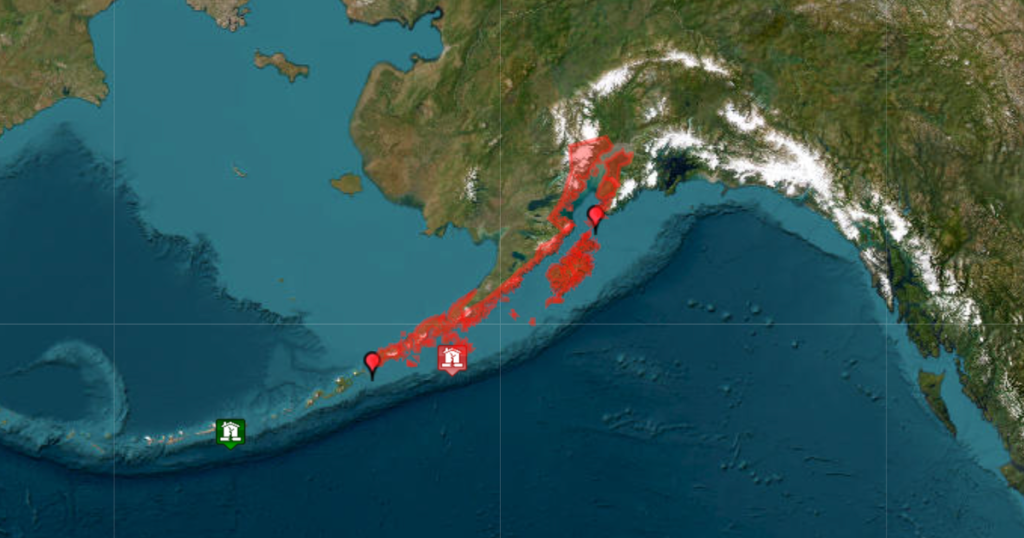A significant earthquake measuring 7.2 on the Richter scale struck off the coast of Alaska, instigating a tsunami advisory for the southern peninsula region. The earthquake occurred approximately 50 miles south of Sand Point at about 12:38 p.m. local time, as reported by the National Weather Service. Fortunately, the tsunami warning was later downgraded, although officials advised caution and monitoring of the situation.
| Article Subheadings |
|---|
| 1) Details of the Earthquake |
| 2) Impact on Local Communities |
| 3) Official Responses and Advisories |
| 4) Historical Context of Earthquakes in Alaska |
| 5) Safety Measures for Residents |
Details of the Earthquake
The earthquake that struck Alaska was reported to have a preliminary magnitude of 7.2 and occurred approximately 50 miles south of Sand Point at 12:38 p.m. local time. According to the National Weather Service, the quake’s depth was about 12 miles. This geological event triggered immediate responses from various monitoring agencies, including the U.S. Geological Survey, which confirmed several aftershocks in the area. Residents experienced tremors throughout the Alaska Peninsula and surrounding regions, indicating the earthquake’s significant reach. Emergency alerts were issued promptly to alert nearby communities.
Impact on Local Communities
Videos shared on social media platforms captured moments of panic as residents in the town of Seward evacuated to higher ground following the tsunami warning. The urgency intensified as the U.S. Coast Guard in Alaska ordered personnel at its Kodiak base to move to higher altitudes. The coastal communities, particularly those along the southwestern shoreline, were actively engaged in precautionary measures. People were advised to avoid all forms of water activities until the cancellation of the tsunami advisory, highlighting the seriousness of the situation. As the incident progressed, local officials conducted emergency assessments to determine any damages or risks to infrastructure.
Official Responses and Advisories
Officials, including Dave Snider, a tsunami warning coordinator at the National Oceanic and Atmospheric Administration, announced a confirmation of a tsunami. However, he assured that widespread and devastating waves were not anticipated. “The good news is this event happened in shallow water,” stated Snider, emphasizing that tidal impacts would be localized rather than far-reaching. Initial warnings were laid out, cautioning citizens to remain vigilant and adhere to guidance from local emergency management. By the afternoon, NWS Anchorage confirmed that there was no danger posed to Anchorage, Alaska’s largest city, alleviating some concerns.
Historical Context of Earthquakes in Alaska
Alaska’s southern coast has a notorious reputation for seismic activity, being part of the Pacific “Ring of Fire.” This region is characterized by frequent earthquakes, with the strongest ever recorded in North America occurring in March 1964. That catastrophic 9.2-magnitude quake devastated Anchorage and resulted in a powerful tsunami that led to over 250 fatalities. Consequently, the state’s residents are particularly aware and prepared for seismic events. Historical data allows for a better understanding of potential earthquake impacts and informs emergency response planning.
Safety Measures for Residents
In light of the recent earthquake and tsunami advisory, residents are encouraged to familiarize themselves with safety measures specific to seismic and tsunami activities. Officials reiterate the importance of maintaining an emergency kit with essential supplies such as food, water, medications, and first aid materials. Community drills and educational programs regarding earthquake preparedness must be prioritized, so residents can act swiftly and appropriately during an actual emergency. Authorities have also appealed to local media to disseminate updated information and alerts, ensuring that citizens remain informed about their safety.
| No. | Key Points |
|---|---|
| 1 | The earthquake measured 7.2 in magnitude and struck about 50 miles south of Sand Point. |
| 2 | Residents evacuated to higher ground due to the initial tsunami warning. |
| 3 | Officials confirmed localized tsunami impacts but not widespread damage. |
| 4 | Alaska’s southern coast is known for its seismic activity, having experienced devastating earthquakes in the past. |
| 5 | Authorities stress the importance of emergency preparedness and safety measures for residents. |
Summary
The recent earthquake off the coast of Alaska serves as a reminder of the region’s seismic vulnerability and the necessity for ongoing safety preparedness. While the tsunami warning was eventually downgraded, the event prompted immediate action from local communities and officials aimed at ensuring safety. Understanding historical contexts and actively engaging in emergency protocols can profoundly affect the readiness of residents amid natural disasters.
Frequently Asked Questions
Question: What are the potential risks associated with earthquakes?
Earthquakes can lead to significant property damage, injuries, and fatalities. Secondary effects such as tsunamis, landslides, and aftershocks pose additional risks.
Question: How can residents prepare for an earthquake?
Residents should create an emergency kit with necessities, educate themselves on evacuation routes, and practice drills to ensure quick and efficient responses during an earthquake.
Question: What should one do during an earthquake?
During an earthquake, people should “Drop, Cover, and Hold On.” Find a sturdy piece of furniture to hide under if possible, protect your head and neck, and stay away from windows and heavy objects.


